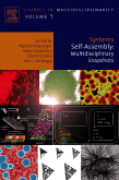
Systems self-Assembly: multidisciplinary snapshots
Krasnogor, Natalio
Gustafson, Steven
Pelta, David A.
Verdegay, Jose-Luis
Self-assembly is a process that creates complex heirarchical structures through the statistical exploration of alternative configurations. These processes occur without external intervention. Self-Assembly processes are ubiquitous innature. Understanding how nature produces self-assembled systems will represent an enormous leap forward in our technological capabilities. Robustness and versatility are some of the most important properties of self-assembling natural systems.Although systems where self-assembly occurs, or which are created by a self-assembling process, are remarkably vaired, some common principles are starting to be discerned. The unifying thread throughout the book is the "ComputationalNature of Self-Assembling Systems. INDICE: Ch. 1: Self-Organised Nanoparticle Assemblies: A Panoply of Patterns Ch. 2: Biomimetic Design of Dynamic Self-Assembling Systems Ch. 3: Computing by Self-Assembly: DNA Molecules, Polyominoes, Cells Ch. 4: Evolutionary Design of a Model of Self-Assembling Chemical Structures Ch. 5: Self-Assembly as an Engineering Concept across Size Scales Ch. 6: Probabilistic Analysis of Self-Assembled Molecular Networks Ch. 7: The ";Programming Language"; of Dynamic Self-Assembly Ch. 8: Self-Assembled Computer Architectures Ch. 9: Simulation ofSelf-Assembly Processes Using Abstract Reduction Systems Ch.10: Computer Aided Search for Optimal Self-Assembly Systems Ch.11: Programmable Self-Assembly-Theoretical Aspects and DNA-Linked Nanoparticles Ch.12: From Microscopic Rules to Emergent Cooperativity in Large-Scale Patterns Ch.13: Automated Self-Assembling Programming
- ISBN: 978-0-444-52865-0
- Editorial: Elsevier Science
- Encuadernacion: Cartoné
- Páginas: 304
- Fecha Publicación: 01/03/2008
- Nº Volúmenes: 1
- Idioma: Inglés
